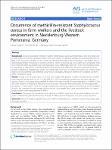Occurrence of methicillin-resistant Staphylococcus aureus in farm workers and the livestock environment in Mecklenburg-Western Pomerania, Germany
Dahms, Carmen
Hübner, Nils-Olaf
Cuny, Christiane
Kramer, Axel
Background: Livestock-associated methicillin-resistant Staphylococcus aureus (LA-MRSA) has a wide host range and is transmissible to humans, especially to those with close contact to colonized animals. This study presents the first data on the occurrence of MRSA in farm workers and livestock farms (pig, cattle and poultry) in the federal state of Mecklenburg-Western Pomerania in northeast Germany. 78 farm workers at pig farms, cattle farms and poultry farms were tested for MRSA via pooled nasal and pharyngeal swabs. Additionally, from each of the 34 participating farms (17 pig farms, 11 cattle farms, 6 poultry farms) five dust samples were taken from the direct surroundings of the animals. Furthermore, oropharyngeal swabs were additionally taken from 10 animals per poultry farm. Isolated MRSA strains were characterized and confirmed using PCR and spa typing. Resistance patterns were obtained using the broth microdilution assay. Results: In total, 20 of 78 (25.6%; 95% CI:17.3-36.3) farm workers were positive for MRSA. All MRSA-positive workers were employed at pig farms. Six of 17 (35.3%; 95% CI:17.3-58.7) pooled dust samples from pig farms were also positive. Overall, six spa types were identified, of which t034 predominated. All strains belonged to LA-MRSA CC398 and were resistant to tetracycline. Resistance to lincosamides, macrolides, fluoroquinolones and aminoglycosides was present in some strains. Three farm workers harbored the identical spa type and antimicrobial resistance pattern found in the corresponding dust sample. Neither workers, dust samples from cattle and poultry farms, nor oropharyngeal poultry swabs tested positive for MRSA. Conclusions: The present study emphasizes the importance of MRSA on pig farms and pig-farm workers in the rural region of Mecklenburg-Western Pomerania, whereas LA-MRSA could not be isolated from cattle and poultry farms.
No license information

